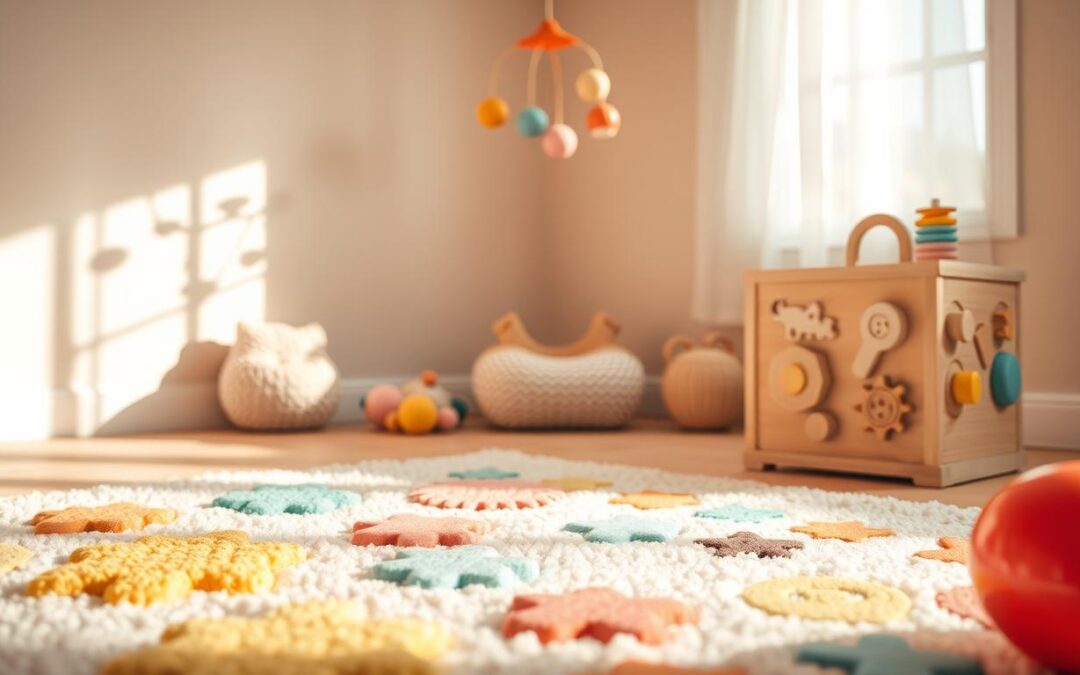Engaging in sensory activities is key for babies’ growth. It stimulates their senses and boosts learning. You can make these activities at home easily.
Sensory play for babies includes sight, sound, and touch. It improves their thinking, creativity, and social skills. Adding sensory play to their day helps them learn a lot.
Parents can make many sensory activities for their babies. This article will show you how. It includes ideas and tips for a stimulating environment that helps with sensory development.
Contents
- 1 What are Sensory Activities and Why Are They Important?
- 2 Safe Materials for Sensory Activities
- 3 Easy DIY Sensory Bins for Exploration
- 4 Creative Water Play Ideas for Sensory Experience
- 5 Making Sensory Bags for Tactile Exploration
- 6 Engaging Arts and Crafts for Sensory Learning
- 7 Using Music and Sounds to Stimulate Senses
- 8 Incorporating Nature into Sensory Activities
- 9 Interactive Storytime for Sensory Engagement
- 10 Tips for Creating a Sensory-Friendly Environment
- 11 Encouraging Social Interaction through Sensory Play
What are Sensory Activities and Why Are They Important?
Sensory activities for infants are a great way to stimulate their senses. They include sight, sound, and touch. These activities are key for their growth, helping with thinking, creativity, and social skills.
Baby sensory toys, like soft blocks and texture balls, make a great environment. They help infants learn and grow.
Stimulating newborn senses is vital. It helps them understand their world. Simple activities like showing different colors or playing soothing music are great. For example, reading books with different textures and colors engages their senses.

- Exploring different tastes and smells
- Playing with playdough or slime
- Listening to various sounds and music
Adding sensory activities to their daily routine is beneficial. It helps infants develop important skills. Remember, every baby is different. So, it’s important to watch and meet their unique needs.
Safe Materials for Sensory Activities
When it comes to baby sensory play, safety is key. Parents want their babies to learn and explore safely. It’s important to pick materials that are safe and gentle on their skin.
Household items like rice, beans, and water are great for sensory activities for newborns. They’re easy to find and can make lots of fun experiences. For example, you can fill a container with rice and hide small toys for a fun activity.
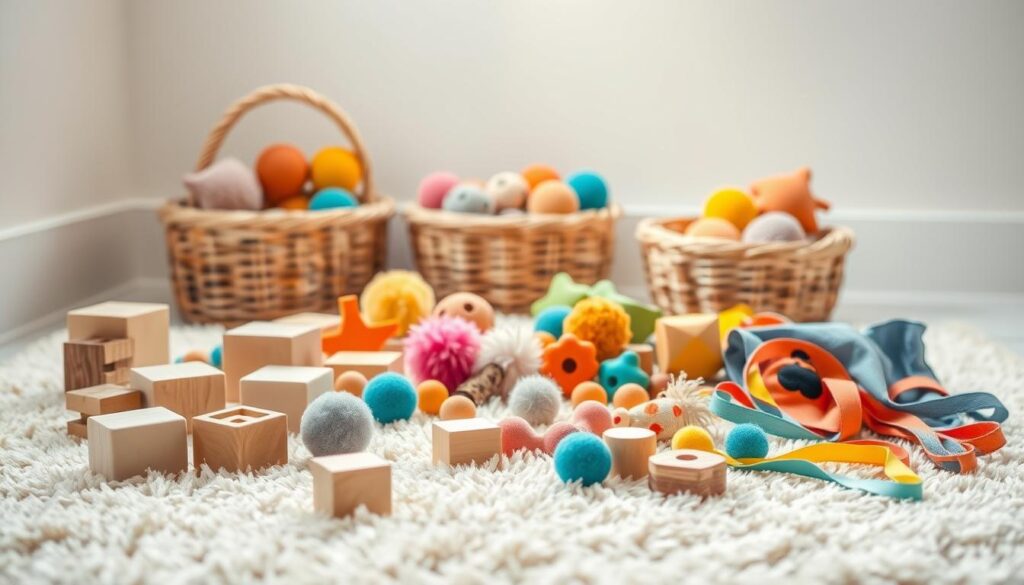
Common Household Items to Use
- Rice
- Beans
- Water
- Sand
Eco-Friendly and Non-Toxic Options
For those who like eco-friendly options, there are many safe choices. Organic fabrics, natural dyes, and plant-based toys are great. They’re safe for babies and good for the planet too.
Avoiding Potencial Hazards
When picking materials for sensory activities, stay away from dangers. Choking hazards and allergies are big concerns. Always watch your baby during play and make sure the materials are safe for their age and needs.
Easy DIY Sensory Bins for Exploration
Creating sensory bins for babies is a great way to help them develop their senses. These bins are filled with materials that stimulate the senses. They help babies improve their fine motor skills and hand-eye coordination.
Starting with a rice and beans sensory bin is a good idea. It offers a tactile experience for babies. You can also try a water bead sensory bin for a fun texture. Or, make a nature-inspired bin with leaves, twigs, and pinecones for a natural feel.
- Filling a bin with sand and hiding small toys for babies to find
- Creating a sensory bin with different textures like play dough, slime, or foam
- Making a music sensory bin with various instruments and objects to explore
Always watch your baby during sensory play. Make sure they have a safe and fun place to learn and explore.
Creative Water Play Ideas for Sensory Experience
Water play is great for sensory activities for babies. It helps with thinking and social skills. Make sure the play area is safe and fun for babies and toddlers.
Use containers and objects like cups, buckets, and sponges for water play. Adding different textures, like rice or beans, to the water can also be fun. Bath time can be a good chance to engage your baby’s senses with toys and objects.
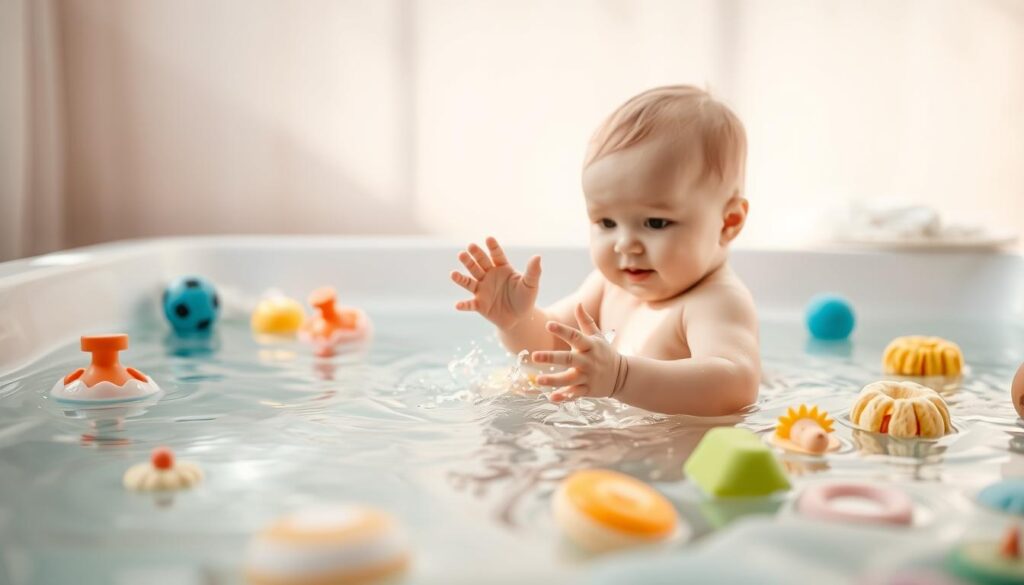
Outdoor water play is also fun and educational. You can set up a water table or a small pool with baby sensory toys. Always watch your baby during water play and keep them safe. Providing various sensory activities for babies helps their senses and supports growth.
Water play has many benefits:
- Improved cognitive skills
- Enhanced social skills
- Stimulated senses
Adding water play to your baby’s daily routine makes learning fun. It’s a great way to support their development.
Making Sensory Bags for Tactile Exploration
Sensory bags for babies are a great way to help them explore through touch. They offer a fun way for your little one to find out about different textures and feelings. These play ideas can also help with fine motor skills and hand-eye coordination, starting a lifelong love of learning.
To start, you’ll need some basic items like fabric bags, fillings like rice or beans, and other objects for texture. Make sure to pick fillings that are safe for your child’s age and abilities. You can also make your sensory bags special for your child, making them a great tool for sensory play.
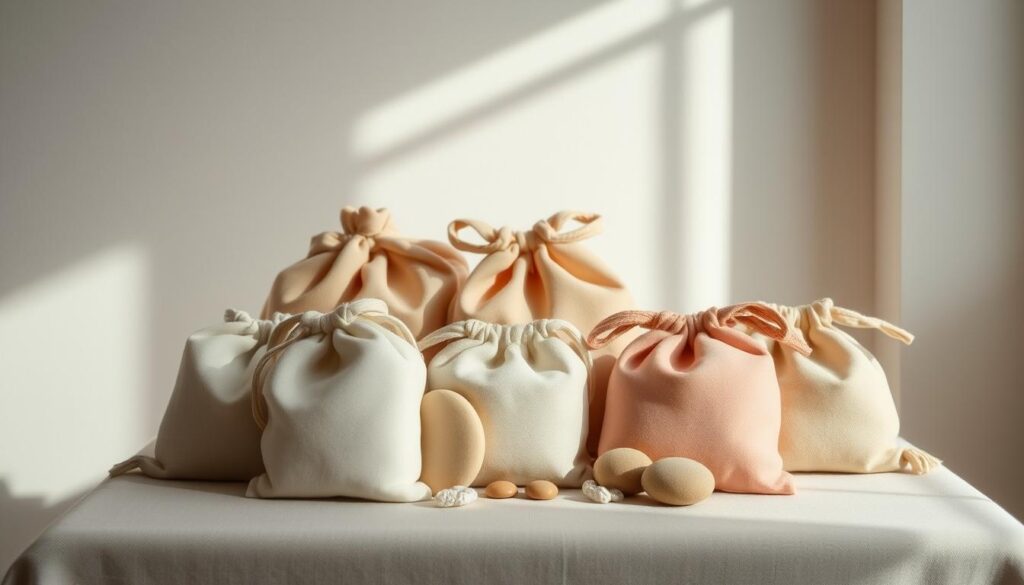
- Rice or beans for a tactile, auditory experience
- Sand or small pebbles for a calming, soothing sensation
- Small toys or other objects for added texture and interest
These are just a few ideas to get you started. With a bit of creativity, you can make many different sensory bags. They can meet your child’s unique needs and help them love sensory play.
Engaging Arts and Crafts for Sensory Learning
Arts and crafts are great for sensory activities for babies. They help with thinking and creativity. Using baby sensory toys and materials, these activities encourage babies to explore and engage.
Activities like finger painting, textured art, and sensory collages are good. They can be changed for different ages and abilities. This makes them perfect for stimulating newborn senses and learning through senses.
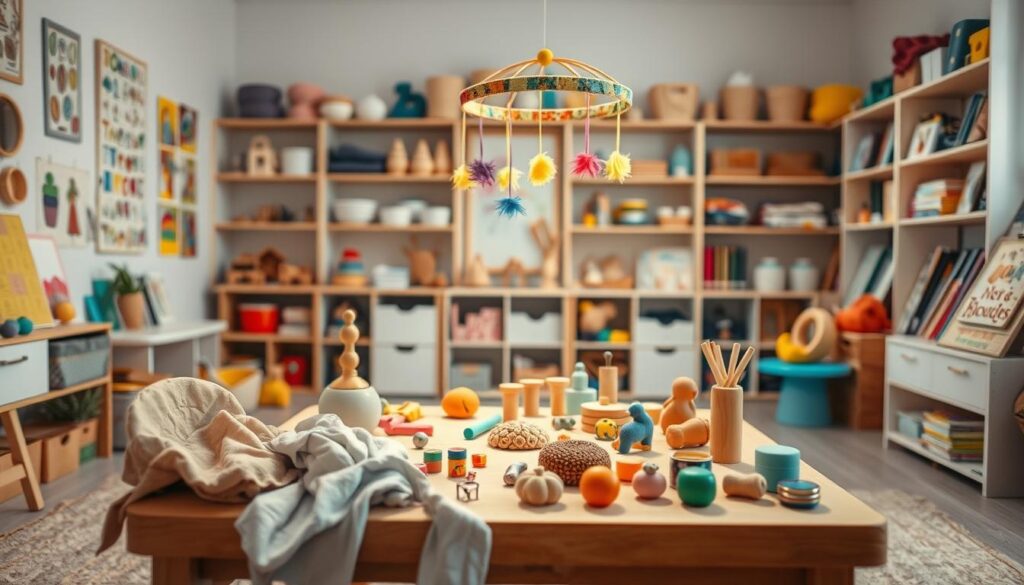
Finger Painting for Babies
Finger painting is a fun way for babies to start arts and crafts. It lets them play with colors and textures in a fun way.
Textured Art Projects
Textured art, like collages and sculptures, is great for babies. It gives them a touch experience. This helps their sense of touch and encourages them to explore.
Sensory Collages: Mixing Sight and Touch
Sensory collages mix different materials like fabrics, papers, and objects. They offer a fun experience that combines seeing and touching.
Using Music and Sounds to Stimulate Senses
Music and sounds are key in sensory activities for infants. They help stimulate their senses and aid in development. Baby sensory play can include musical instruments like xylophones and drums. These can create different sounds and rhythms.
Even everyday objects can make sounds, like pots and pans. They can be used to make a drum set. This sensory experiences for babies helps them develop their hearing and explore their surroundings.
Musical Instruments for Babies
- Xylophones
- Drums
- Maracas
Sound Exploration with Everyday Objects
Using everyday objects to make sounds is fun and engaging. For example, filling a container with different beads or rice makes sounds when moved. It’s a great way to promote sensory activities for infants.
Creating a Dance Party at Home
Hosting a dance party at home is a fun way to encourage baby sensory play. Play some upbeat music and let your baby dance. You can also use balloons or other objects to make it more interactive.
Incorporating Nature into Sensory Activities
Nature is full of chances for sensory activities for babies. It lets them see, hear, and touch the world. Simple things like walking outside, picking leaves, or planting a garden can help.
Here are some ideas for nature-based sensory activities:
- Sensory walks: Take a walk with your baby and encourage them to collect items from nature, such as leaves or pinecones.
- Collecting natural items: Collect items like rocks, sticks, or flowers, and use them to create a sensory bin or collage.
- Gardening activities: Plant a garden with your baby and let them help with watering, digging, and harvesting.
These activities can stimulate newborn senses. They make learning fun and engaging. Using baby sensory toys and nature helps babies develop skills like problem-solving and hand-eye coordination.
By adding nature to sensory activities, parents can foster a love for the outdoors. It’s a fun way for kids to learn and grow.
Interactive Storytime for Sensory Engagement
Interactive storytime is a fantastic way to engage infants in sensory activities. It promotes cognitive development and sparks a love for reading. Parents and caregivers can make stories come alive with sensory experiences. For instance, touch-and-feel books offer a tactile experience, while sound books stimulate hearing.
When picking out sensory storybooks, think about the baby’s age and interests. Board books with textures, pop-up books, and books with mirrors are great choices. Adding movement and sound to storytime can make it even more engaging. Try using puppets or stuffed animals to act out the story, or play music that fits the story.
To make storytelling even better, try dress-up or role-playing. These activities help babies use their imagination and creativity. They also offer chances for sensory play. Here are some more ideas for interactive storytime:
- Using scents or smells to bring the story to life
- Creating a sensory bin or container to explore during storytime
- Incorporating music or singing into the story
By adding sensory activities to storytime, parents and caregivers can make learning fun. Baby sensory play is key to cognitive development. Interactive storytime is a great way to offer sensory experiences in a fun and engaging manner.
Tips for Creating a Sensory-Friendly Environment
Creating a sensory-friendly space is key for babies to explore and learn. Simple things like different textures, sounds, and smells can help. Toys like soft blocks, sensory balls, and fabric books are great for stimulating their senses.
Designing Play Spaces for Exploration
Think about what sensory activities you can add to play areas. For instance, a space with various textures like carpet, wood, and fabric is great. Adding music, lights, and colors can make it even more engaging.
Organizing Sensory Materials
Keep sensory materials organized with bins and baskets. This makes the space tidy and easy for babies to find what they need. Labels and categories help parents and caregivers quickly find different activities.
- Soft toys and fabrics
- Sensory balls and blocks
- Music and sound instruments
By following these tips, you can make a space that encourages babies to explore and learn.
Encouraging Social Interaction through Sensory Play
Sensory activities do more than just excite a child’s senses. They also help kids learn to work together and share. By doing group projects, like making a sensory bin or art, kids improve their communication and teamwork skills.
Group Sensory Activities for Playdates
Playdates with sensory fun are great for kids to get along. Activities like water bead bins or nature walks let them share and learn together. This helps them grow socially and emotionally.
Teamwork in Sensory Projects
When kids work on sensory projects together, they learn to collaborate. Projects like making a collage or a musical instrument teach them to share ideas and solve problems. These experiences help them grow closer and learn to work as a team.
Benefits of Sharing Sensory Experiences
Sharing sensory moments with others is very beneficial for kids. It helps them become more aware of others, understand different views, and grow emotionally. All while they get to explore and enjoy the world around them.

